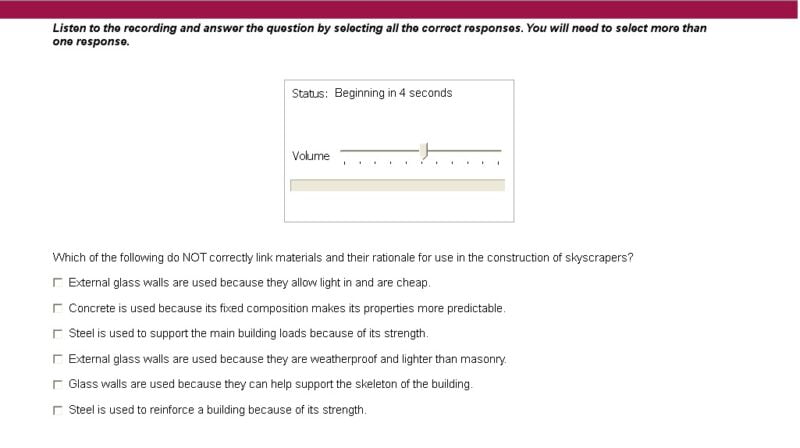
The Pearson Test of English (PTE) Academic is a widely recognized English proficiency test that assesses the language skills of non-native English speakers. Among its four sections—Speaking, Writing, Reading, and Listening—the Listening section plays a crucial role in evaluating a test-taker’s ability to comprehend spoken English in various contexts. This section tests not only how well you can understand spoken English but also how effectively you can recall and analyze the information presented.
In this blog post, we’ll dive deep into the Listening section of the PTE Academic test. We’ll explore each type of question you’ll encounter, explain what’s expected, and provide insights into how many of each type of question you might face during the test.
Overview of the PTE Academic Listening Section
The Listening section of the PTE Academic test lasts approximately 45-57 minutes and consists of 8 distinct question types. These questions are designed to assess your ability to understand spoken English in different accents and contexts. The audio clips range from 30 seconds to 3 minutes in length and include academic lectures, discussions, and everyday conversations.
The questions are presented in the order of the test, which starts with the easier tasks and progresses to more challenging ones. Understanding the structure of this section is crucial, as it will help you manage your time effectively and maximize your score.

Question Types in the PTE Academic Listening Section
| Listening (30 to 43 minutes) | Number of questions |
|---|---|
| Summarize Spoken Text | 1 – 2 |
| Multiple-Choice, Choose Multiple Answers | 1 – 2 |
| Fill in the Blanks | 2 – 3 |
| Highlight Correct Summary | 1 – 2 |
| Multiple-Choice, Choose Single Answer | 1 – 2 |
| Select Missing Word | 1 – 2 |
| Highlight Incorrect Words | 2 – 3 |
| Write from Dictation | 3 – 4 |
Summarize Spoken Text
This is the first question type in the Listening section. You’ll listen to a short lecture or a talk, and your task is to summarize the key points in 50-70 words.
Focus on the main idea and supporting details. Take notes while listening, as this will help you organize your summary effectively.
Multiple-Choice, Choose Multiple Answers
In this task, you’ll listen to an audio recording and answer a multiple-choice question with several correct answers. The options are provided in written form, and you must select all the correct answers.
Listen carefully for specific details and key phrases that match the options provided. Avoid guessing, as selecting incorrect options will reduce your score.
Fill in the Blanks
You’ll listen to a recording and see a transcript with several blanks. Your task is to fill in the missing words based on what you hear.
Pay attention to the context and grammar of the sentence. The missing words are often key content words, so focus on listening for important nouns, verbs, and adjectives.
Highlight Correct Summary
After listening to an audio clip, you’ll be presented with several written summaries. Your task is to choose the summary that best reflects the content of the recording.
Focus on the main idea of the recording and eliminate summaries that contain incorrect or irrelevant details.
Multiple-Choice, Choose Single Answer
Similar to the multiple-choice question with multiple answers, this task involves listening to a recording and answering a single question. However, only one answer is correct.
Listen for the main idea and specific details that directly answer the question. Eliminate options that are partially correct or irrelevant.
Select Missing Word
You’ll hear a recording where the last word or group of words is replaced by a beep. Your task is to select the correct option that completes the sentence logically.
Focus on the overall context and tone of the recording. The missing word(s) usually match the style and meaning of the entire passage.
Highlight Incorrect Words
You’ll listen to a recording while reading a transcript. The transcript contains some errors, and your task is to identify and click on the incorrect words.
Follow along with the transcript as you listen to the recording. The errors are typically content words rather than grammatical mistakes.
Write from Dictation
This is the final task in the Listening section. You’ll hear a sentence and must type it out exactly as you hear it.
Listen carefully to the entire sentence before you start typing. Pay attention to punctuation and capitalization, as these are also assessed.

Read also:
Time Management and Scoring
The Listening section of the PTE Academic test is adaptive, meaning the difficulty of the questions can vary based on your performance. Managing your time effectively is crucial. Some questions, such as “Summarize Spoken Text,” require more time to complete, while others, like “Write from Dictation,” are relatively quicker.
The scoring in this section is automated, and each question type contributes differently to your overall Listening score. For example, “Fill in the Blanks” and “Write from Dictation” directly assess your listening and writing skills, while multiple-choice questions test your ability to understand and recall specific details.
| Question type | Number of questions | Speaking score | Writing score | Reading score | Listening score | % of Total score |
|---|---|---|---|---|---|---|
| Repeat sentence | 10 – 12 | 32.1 | 19.7 | 14.39 | ||
| Write from dictation | 3 – 4 | 26.8 | 19.7 | 12.92 | ||
| Summarize spoken text | 1 – 2 | 11.9 | 13.1 | 6.94 | ||
| Re-tell lecture | 1 – 2 | 11.1 | 9.9 | 5.81 | ||
| Highlight incorrect words | 2 – 3 | 8.9 | 7.9 | 4.64 | ||
| Listening: Fill in the blanks | 2 – 3 | 7.4 | 6.6 | 3.88 | ||
| Answer short question | 5 – 6 | 2.4 | 6.6 | 2.50 | ||
| Highlight correct summary | 1 – 2 | 1.5 | 1.3 | 0.77 | ||
| Listening: Multiple choice, choose multiple answers | 1 – 2 | 2.6 | 0.72 | |||
| Listening: Multiple choice, choose single answer | 1 – 2 | 1.3 | 0.36 | |||
| Select missing word | 1 – 2 | 1.3 | 0.36 |
You can see from the above table that some questions that are not part of the Listening section contribute to the Listening score, while certain questions from the Listening section determine the scores for other sections as well. Among all the questions, Repeat Sentence, Write from Dictation, Summarize Spoken Text, and Re-tell Lecture are the most important. On the other hand, the two types of Multiple Choice Questions and Select Missing Word are not as crucial in terms of their contribution to the overall score.
You may also like:
How to improve Listening?
Improving your Listening score in the PTE Academic test requires a combination of strategic preparation, practice, and developing strong listening skills. Here are some effective tips to help you boost your Listening score:
1. Familiarize Yourself with the Test Format
- Understand the Question Types: The Listening section has 8 different question types. Familiarize yourself with the format, instructions, and what each question type requires.
- Practice Each Question Type: Use PTE practice tests or online resources to get used to the types of questions you’ll encounter, such as “Summarize Spoken Text,” “Multiple-Choice,” and “Write from Dictation.”
2. Develop Active Listening Skills
- Listen to Various English Accents: The PTE Listening section includes speakers with different accents, such as British, American, Australian, and Canadian. Practice listening to these accents by watching movies, listening to podcasts, or following news channels from these regions.
- Focus on Main Ideas and Details: Train yourself to identify the main idea and key details in any audio clip. Pay attention to how speakers emphasize important points, as this can help you answer questions more accurately.
3. Practice Note-Taking
- Develop Effective Note-Taking Techniques: Practice taking notes while listening to audio clips. Focus on writing down key points, such as names, dates, figures, and main ideas, rather than trying to write down everything.
- Use Abbreviations and Symbols: Create your own system of abbreviations and symbols to jot down information quickly. This will help you keep up with the pace of the audio.
4. Improve Your Vocabulary
- Expand Your Lexicon: A broader vocabulary will help you understand and recognize more words during the test, especially in the “Fill in the Blanks” and “Highlight Incorrect Words” sections.
- Practice Contextual Understanding: Learn to understand words based on the context they are used in, which is particularly useful for “Select Missing Word” and “Multiple-Choice” questions.

5. Enhance Your Dictation Skills
- Practice Writing from Dictation: Regularly practice the “Write from Dictation” task by listening to short sentences and typing them out exactly as you hear them. Pay attention to spelling, punctuation, and grammar.
- Use Online Tools: Utilize online dictation tools or mobile apps that allow you to practice this skill. These tools can also help you identify areas where you need improvement.
6. Work on Your Concentration
- Stay Focused During Practice: Practice staying focused while listening to long audio clips. Gradually increase the length and complexity of the audio you listen to, which will help you maintain concentration during the test.
- Minimize Distractions: Practice in a quiet environment to simulate test conditions and train yourself to avoid getting distracted by background noise.
7. Time Management
- Practice Under Timed Conditions: Simulate the test environment by practicing each section within the time limits. This will help you get used to managing your time effectively during the actual test.
- Prioritize High-Scoring Sections: Focus on improving your performance in higher-scoring sections like “Summarize Spoken Text” and “Fill in the Blanks,” as these can significantly impact your overall score.
8. Review and Analyze Practice Tests
- Identify Weak Areas: After taking practice tests, review your answers and identify areas where you struggle. Focus on improving these areas in subsequent practice sessions.
- Learn from Mistakes: Analyze your mistakes and understand why you got a question wrong. This will help you avoid similar errors in the future.
9. Use PTE Prep Resources
- Official PTE Practice Materials: Use official PTE Academic practice tests and study guides, which are designed to closely replicate the actual test.
- Online Courses and Tutorials: Consider enrolling in an online PTE preparation course or watching tutorial videos that offer strategies and tips for improving your Listening score.
10. Stay Calm and Confident
- Maintain a Positive Mindset: Confidence plays a key role in performing well on the test. Believe in your preparation, and approach the test with a calm and focused mind.
- Practice Relaxation Techniques: If you tend to get anxious during tests, practice relaxation techniques such as deep breathing or meditation to help manage stress during the Listening section.
Improving your Listening score in the PTE Academic test requires consistent practice, strategic preparation, and a focus on developing strong listening and comprehension skills. By incorporating these tips into your study routine, you can enhance your performance in the Listening section and move closer to achieving your desired score. Remember, practice is key, so make listening to English a part of your daily routine, and you’ll see steady improvement over time.
Conclusion
The Listening section of the PTE Academic test is a comprehensive assessment of your ability to understand spoken English in various contexts. By familiarizing yourself with the different question types and practicing regularly, you can improve your listening skills and boost your overall score. Remember to manage your time wisely and focus on the main ideas and key details in each audio recording. With the right strategies and preparation, you can confidently tackle the Listening section and achieve your desired score.
See also:
- PTE vs IELTS: Similarities and differences simplified
- PTE Describe Image format: Tried and tested template for 2024
Gaurav Thapa is an experienced instructor of English as a Foreign Language. He has eight years of experience teaching IELTS and PTE.